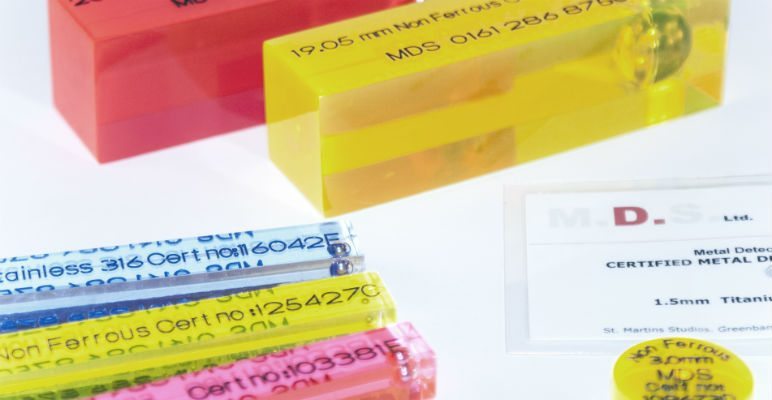At MDS we understand the need for certified and traceable test pieces to ensure the correct operation of your equipment. All of our metal detector test pieces are manufactured from food grade FDA approved materials and are traceable via an ID number, engraved, not stamped, to ensure they remain legible. All of our metal detector test samples are certified and come with a certificate of compliance.
Sample Testing
All MDS test pieces are thoroughly scrutinised throughout the manufacturing process and conform to rigorous manufactures’ tests confirming their spherical size with quantitative and qualitative testing to ensure precise certified material content.
We are able to supply a range of standard test samples with ball sizes from 0.2mm to 20.0mm in the following materials:
- Ferrous
- Non Ferrous
- Stainless
- Aluminium
Test pieces can be supplied as:
- Sticks
- Spheres
- Rods
- Cards
- Discs
If you require a specific, bespoke, encapsulated test sample simply contact us with your requirements.
Tips and advice when selecting samples
Are you using the correct size samples for your detector? Product, product temperature, detector aperture height and width, frequency, electrical noise all effect sensitivity. If you are in any doubts please call our service team for advice on selection.
Test your metal detectors at regular intervals, every hour is common practice, use three test samples made from ferrous, non-ferrous and 316 stainless steel. 316 stainless steel samples are used for their non-magnetic properties, meaning that it is one of the most difficult grades of stainless steel for a metal detector to find. If it can find 316 s/s then it should be capable of picking up other grades too.
When testing your metal detector the recognised conventional position to place the test sample is:
- Either, on the product, if the product height is below the centre point of the aperture,
- Or, in the product, at a height approximately equal to the centre point of the aperture.
The reason for this is that in nearly all cases, the weakest point of the detection field is the exact centre (half height and half width) of the aperture. So by placing the test piece this way, it will always pass through the weakest point of the detection field and so confirm that the test piece is detectable at all other points within the product where the field is stronger.
Always use three test samples as the detector may in some cases detect one kind of metal but not the others due to tuning drift.
Test samples are colour coded as follows:
FE = Ferrous RED
NFE = Non-Ferrous YELLOW
SS = Stainless Steel BLUE
If you need help or advice on any of the points raised please feel free to call our service team on 0161 286 8750.

